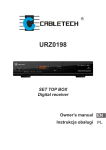Download Moxa Technologies VPort 251 Installation guide
Transcript
Moxa Video Encoder VPort 251 Series Quick Installation Guide Second Edition, June 2008 © 2008 Moxa Inc., all rights reserved. Reproduction without permission is prohibited. P/N:1802002510010 Overview The VPort 251 is a high performance, 1-channel video encoder in a compact form factor that is suitable for installation in a variety of locations, including outdoor camera cabinets. For easier installation, the VPort 251 supports both panel mounting and DIN-rail mounting (with DK-35A accessory), and includes a loop-through power output that can be used to power an analog camera. In addition, the VPort 251 supports full-motion video at D1 resolution (720 × 480 at 30 FPS for NTSC, 720 × 576 at 25 FPS for PAL). Both MPEG4 and MJPEG are supported, making the VPort 251 especially suited for use with distributed video surveillance systems. 2-way audio support is also built in, allowing real-time voice communication between field engineers and control centers. Package Checklist The VPort 251 is shipped with the following items. If any of these items are missing or damaged, please contact your customer service representative for assistance. y y y y y y y VPort 251 y y 4 pcs pad 5-pin terminal block for 1 DI and 1 relay output 2-pin terminal block for loop-through power output 5-pin terminal block for RS-232/422/485 PTZ control port Quick Installation Guide Power adaptor (Need to order seperately) Documentation & Software CD (includes User’s Manual, Quick Installation Guide, datasheet, and utility) Warranty booklet NOTE Please verify that the model name printed on the unit's side label is correct for your order. NOTE This product must be installed in compliance with your local laws and regulations. Features High Performance Video/Audio Networking Solution y y y y y y y y Supports NTSC/PAL analog video cameras Supports MPEG4/MJPEG video compression technology 1 BNC video input 1 audio input and 1 audio output for 2-way voice communication Standard RTSP (real-time streaming protocol) for easy integration Multicast (IGMP) protocols for efficient network transmission QoS (TOS) for priority transmission Full D1, 4CIF, VGA, QVGA, and CIF video resolutions -2- y y 1 auto-sensing 10/100BaseT(X) Ethernet port y "Transparent PTZ Control" function to control remote PTZ cameras with legacy PTZ control panel or keyboard y Built-in web server and RS-232 console for remote and local access & configuration y y y y y TCP, UDP, and HTTP network transmission modes RS-232/RS-422/RS-485 COM port for controlling PTZ (pan/tilt/zoom) motorized cameras Simultaneous access for up to 10 clients Set video quality to CBR (constant bit rate) or VBR (variable bit rate) Timestamp and text overlay DDNS (Dynamic DNS), UPnP and IP filtering supported Intelligent Alarm Trigger y y Built-in video motion detection (VMD) y y y y Alarm-triggered snapshots with pre-alarm and post-alarm snapshots y Configurable schedule for alarm activation 1 digital input channel and 1 relay (digital) output channel for external sensor and alarm Sequential snapshot images Messages with snapshot images sent by FTP or email HTTP action settings for customized alarm messages sent by HTTP event server Convenient Hardware Installation y Compact form factor for installation at almost any location y Panel mounting and DIN-rail mounting (with DK-35A accessory) y Loop-through power output with identical range as power input, for powering analog cameras Video Management and Control y Moxa SoftDVR™ Lite IP surveillance software included for viewing and recording y Free VPort SDK PLUS available, with flexible interface and sample codes for customized applications NOTE If you are interested in the VPort SDK PLUS, please visit moxa.com to download the software, or contact a Moxa sales representative for more information. -3- VPort 251 Panel Layout 1. Grounding point 4 6 3 2. Power input jack (12 to 32 5 VDC or 18 to 30 VAC) 2 1 3. 5-pin terminal block for digital input and relay output 4. Hardware reset button 5. 10/100BaseTX Ethernet port with RJ45 connector, LEDs 6. Status LEDs 7. Audio input jack 251 13 1-Channel Video Encoder Video Input Compression MPEG4 or MJPEG Ethernet Auto 10/100 Mbps Protocols TCP,UDP,HTTP,DHCP,SMTP, FTP,NTP,DNS,RTSP,IGMP, QoS,DDNS,SNMP GPIO 14 1-ch NTSC/PAL RS-232 or RS-422/485 1x power input and 1x loop power output (for speakers) 15 9. Vpp BNC connector for D1x1,Relay Outputx1 PTZ POWER (mic in or line in) 8. Audio output jack video input 10. 2-pin terminal block for loop-through power output 11. RS-232 console port 12. 5-pin terminal block for RS-232/422/485 13. Model name 12 11 8 14. Mounting point for wall mounting 7 9 15. Mounting point for DK-35A 10 DIN-Rail Kit NOTE The 2-pin terminal block for loop-through power output can be used as an alternative power input port. -4- Initial Installation and Configuration Before installing the VPort 251, verify that all items in the package checklist are present. In addition, you will need a notebook or PC equipped with an Ethernet port to complete the installation. Step 1: Connect the power source, and connect loop-through power output if required. The VPort 251 can be powered by a 12 to 32 VDC power source, or an 18 to 30 VAC power source. The power input jack accepts a concentric barrel-type connector. The loop-through power output accepts a 2-pin terminal block connector. Check the STAT LED on the top panel to verify that power is connected correctly. NOTE The VPort 251's power output is looped through the power input and will match the voltage of the power input source. For example, if the power input is 12 VDC, the loop-through power output will also be 12 VDC. Step 2: Connect the VPort to the network. The VPort 251 has an auto-sensing 10/100 Mbps Ethernet port, with built-in LEDs to show 10 Mbps (amber) or 100 Mbps (green) connection activity. Step 3: Connect the VPort to a camera and an audio source. Use a coaxial cable to connect a video camera to the VPort's VIDEO INPUT port, which uses a BNC connector. A microphone or an amplifier can be plugged directly into the VPort's AUDIO INPUT jack, and a speaker can be plugged into the AUDIO OUTPUT jack. NOTE Check the VIDEO LED on the top panel to verify that the video connection is working properly. Step 4: Connect the VPort 251 to a motorized PTZ camera/device. If you are using a PTZ camera or device, you can connect the PTZ control cable to the VPort to allow PTZ control over the network. A 5-pin terminal block for RS-232/422/485 serial connections is provided for this purpose. The pin assignments are shown below: PIN 1 2 3 4 5 RS-422/485 Ground GND RxRRx+ R+ Tx-/ DataT-\DTx+/ Data+ T+\D+ GND --RxD --TxD RS-232 Ground N/A RxD N/A TxD To enable PTZ control, configure the PTZ control protocol in the VPort's web-based manager. -5- NOTE Drivers are required to support specific PTZ control protocols. The VPort 251 supports the following protocols: y y y Pelco D Pelco P DynaColor DynaDome For other protocols, please contact the video camera manufacturer for the PTZ control commands. You may then use the VPort 251’s Custom Camera function to program PTZ control. NOTE New PTZ drivers can be uploaded for the VPort 251. Please contact a Moxa sales rep to discuss development of new PTZ drivers. NOTE The “Transparent PTZ Control” function can be used for PTZ camera control over the network, without requiring special PTZ drivers. PTZ cameras can be directly controlled by a keyboard or PTZ control panel on the network. Step 5: Configure the VPort’s IP address. After powering on the VPort 251, wait a few seconds for the POST (Power On Self Test). The STAT LED will turn green when the POST is completed. The NETWORK LED will blink as the IP address is assigned. The IP address will be selected according to the network environment. Network Environment with DHCP Server In this case, the VPort's IP address is assigned by a DHCP server. Use the DHCP server’s IP address table or Moxa's VPort utility to look up the IP address that was assigned to the VPort. Using VPort and EtherDevice Configurator 1. Run edscfgui.exe to start VPort and EtherDevice Configurator. Select Broadcast Search from the List Server menu to search for the VPort on the network. NOTE VPort and Ether Device Configurator can be downloaded at www.moxa.com. 2. The Broadcast Search window will show a list of all EDS switches and VPorts located on the network. -6- 3. When the search is complete, every EDS switch and VPort found on the network will be listed onscreen. NOTE Broadcast Search can only search for devices connected to the same LAN domain as the PC running the utility. If your devices are located on different LAN domain, use the Specify IP Address function to search for a specific IP address. 4. Double-click the selected VPort, or use a web browser to access the VPort’s web-based manager (web console). Network Environment without DHCP Server If your VPort is connected to a network that does not have a DHCP server, then you will need to configure the VPort's IP address manually. The default IP address of the VPort 251 is 192.168.127.100 and the default subnet mask is 255.255.255.0. Make sure that you change your computer’s IP address and subnet mask so that the computer is on the same subnet as the VPort. Open the VPort’s web-based manager (see Step 6) and navigate to the System Configuration Æ Network Æ General page. Select Use fixed IP address to ensure that the IP address you assign is not deleted each time the VPort is restarted. Step 6: Open the VPort's web-based manager In a web browser, enter the VPort's IP address as the URL to open the VPort's web-based manager. Step 7: Install the ActiveX Control plug-in When you first access the VPort’s web-based manager, a message will appear regarding the installation of the VPort ActiveX Control component. Click "Yes" to allow the display of video images in the web browser. -7- NOTE For Windows XP SP2 or above, the ActiveX Control component may be automatically blocked for security reasons. In this case, the warning message may not appear. Unblock the ActiveX control function or disable the security configuration to allow installation of the VPort ActiveX Control component. Step 8: Continue to the VPort’s web-based manager After installing the ActiveX Control component, the VPort’s web-based manager will appear. Check the following items to verify that the system was installed properly: y y y Video images Audio (make sure your PC’s or notebook’s sound is turned on) Video information Step 9: Access the VPort’s system configuration In the VPort's web-based manager, the model name, server Name, IP address, MAC address, firmware version, and LED status will be displayed at the top of the page. Use this information to verify system information and installation. Click System Configuration to see an overview of the system configuration. -8- For details on each item, please refer to the User’s Manual. NOTE Administrators should go to System Configuration Æ System Æ Account in the VPort’s web-based manager to set the administrator’s password and enable authentication. The administrator account name is admin. Each time the web-based manager is opened, an authentication window will ask for the account name and password. Mounting Dimensions (unit=mm) 63.6 31.1 37.55 31.6 14.6 18 36.1 47.5 50 66.1 50 88.2 VPort 251 1-Channel Video Encoder 106 25 43 125.6 100.2 88.2 60.3 22.6 18.5 14.6 18.8 66.1 28.1 -9- 33.3 37.1 11 44.1 DIN-Rail Mounting (Optional) The VPort 251 can be mounted on a 35-mm DIN-rail using the DK-35A accessory (ordered separately). Wall Mounting The VPort 251 can be mounted on the wall with 2 screws. Make sure that screws are less than 3.5 mm in diameter, with heads between 3.5 and 6.0 mm in diameter, as shown on the right. 6.0 mm 3.5 mm VPort 251 1-Channel Video Encoder Wiring Requirements ATTENTION Safety First! Be sure to disconnect the power cord before installing or wiring the VPort. Determine the maximum current for each power wire and common wire. Observe all electrical codes dictating the maximum current allowed for each wire size. If the current exceeds the maximum ratings, the wiring could overheat, causing serious damage to your equipment. - 10 - You should also pay attention to the following: y y y y Use separate paths to route wiring for power and devices. If power wiring and device wiring paths must cross, make sure the wires are perpendicular at the intersection point. NOTE: Do not run signal or communications wiring and power wiring in the same wire conduit. To avoid interference, wires with different signal characteristics should be routed separately. You can use the type of signal transmitted through a wire to determine which wires should be kept separate. The rule of thumb is that wiring that shares similar electrical characteristics can be bundled together. Keep input wiring and output wiring separated. It is strongly advised that you label wiring to all devices in the system when necessary. Grounding the VPort 251 Grounding and wire routing help limit the effects of noise from electromagnetic interference (EMI). Before connecting devices, run the ground connection from the grounding point on the VPort to the grounding surface. ATTENTION This product is intended to be mounted to a well-grounded mounting surface such as a metal panel. Wiring the Relay Output The VPort 251 has one set of relay outputs, labeled RELAY. 3 contacts on the 5-pin terminal block on the VPort's top panel are used for the relay output. The relay output can be used for the following: y System alarm, such as for network disconnection y Event alarm, such as for VMD (video motion detection), video loss, or digital inputs The maximum current and power capacity of the relay output is 24 VDC @ 1A. Please be careful not to exceed this power specification. Before connecting the VPort to the DC/AC power inputs, make sure that the DC power source voltage is stable. Wiring the Digital Inputs The VPort 251 has one digital input channel, labeled DI. Two contacts on the 5-pin terminal block on the VPort's top panel are used to connect to this DI. - 11 - STEP 1: Insert the negative (ground)/positive DI wires into the ┴/I1 terminals. STEP 2: To keep the DI wires from pulling loose, use a small flathead screwdriver to tighten the connection. STEP 3: Insert the terminal block connector into the receptor on the VPort’s top panel. Communication Connections The VPort 251 has an RS-232 console port and a 10/100BaseT(X) Ethernet port, which both use RJ45 connectors. RS-232 Connection The RS-232 console port is on the top panel and uses a 10-pin RJ45 connector. Use an RJ45-to-DB9 or RJ45-to-DB25 cable to connect your PC COM port to the console port. Cable wiring diagrams are shown below. You may then use a console terminal program, such as Moxa's PComm Terminal Emulator, to open the VPort’s console configuration utility. RJ45 (10-pin) Console Port Pin Assignment Pin 1 2 3 4 5 6 7 8 9 10 Description --DSR --GND TxD RxD GND --DTR --- 1 10 RJ45 (10-pin) to DB9(F) Cable Wiring RJ45 Plug Pin 1 1 DCD 2 DSR 3 RTS GND 4/7 5 TxD 6 RxD 8 CTS 9 DTR 1 6 7 5 3 2 8 4 - 12 - DCD DTR CTS GND RxD TxD RTS DSR RJ45 (10-pin) to DB25 (F) Cable Wiring RJ45 Plug Pin 1 1 DCD 2 DSR 3 RTS GND 4/7 5 TxD 6 RxD 8 CTS 9 DTR 8 6 4 7 2 3 5 20 DCD DTR CTS GND RxD TxD RTS DSR 10/100BaseT(X) Ethernet Port Connection The 10/100BaseT(X) port is on the VPort 251’s front panel and is used to connect to Ethernet-enabled devices. The following table shows pinouts for both MDI (NIC-type) ports and MDI-X (hub/switch-type) ports. Cable wiring diagrams are also provided for straight-through and cross-over Ethernet cables. (MDI) Port Pinouts Pin 1 2 3 6 (MDI-X) Port Pinouts Signal Tx+ TxRx+ Rx- Pin 1 2 3 6 8-pin RJ45 Signal Rx+ RxTx+ Tx- 1 RJ45 (8-pin) to RJ45 (8-pin) Straight-Through Cable Wiring Straight-Through Cable Switch Port RJ45 Plug Pin 1 RJ45 Connector Tx+ TxRx+ Rx- VPort Ethernet Port RJ45 Connector Cable Wiring 3 6 1 2 3 6 1 2 Rx+ RxTx+ Tx- RJ45 (8-pin) to RJ45 (8-pin) Cross-Over Cable Wiring Cross-Over Cable VPort Ethernet Port NIC Port RJ45 Plug Pin 1 RJ45 Connector (Rx+) (Rx-) (Tx+) (Tx-) Tx+ TxRx+ Rx- RJ45 Connector Cable Wiring 3 6 1 2 1 2 3 6 - 13 - Rx+ RxTx+ Tx- (Tx+) (Tx-) (Rx+) (Rx-) 8 PTZ Port A PTZ port is located on the VPort 251’s bottom panel. The port is used to connect to a PTZ motorized camera or device, so that the camera or device can be controlled from the VPort over the IP network. The PTZ port supports RS-232 or RS-422/485 signals through the terminal block, with pin assignments as shown in the following table: Pin Assignment PIN RS-422/485 RS-232 1 GND GND 2 R--3 R+ RxD 4 T-/D--5 T+/D+ TxD PTZ 5 4 3 2 1 LED Indicators Several LED indicators are located on the front panel of the VPort 251: LED Color RED STAT GREEN VIDEO PTZ GREEN State Description On Hardware initialization Flashing Software initialization On System boot-up Flashing Firmware upgrade proceeding On Video signal is detected Off Video signal is not detected On RS-232 or RS-485 signals are being transmitted Off RS-232 or RS-485 signals are not being transmitted or have not been detected GREEN Hardware Reset The RESET button restores the system to the factory default settings. When the system fails to install properly or operates abnormally, use a pointed object, such as a straightened paper clip or toothpick, to hold the reset button down for several seconds. When the STAT LED blinks red, release the button. The POST process will run and the VPort will reboot. The STAT LED will glow a steady green when the VPort has finished rebooting. - 14 - Specifications Video Video Compression MPEG4, MJPEG Video Input 1, BNC connector NTSC/PAL Auto-sensing or manual Video Resolution and FPS (frames per second): QVGA CIF VGA 4CIF Full D1 Video Viewing NTSC PAL Size Max. FPS Size Max. FPS 320 × 240 30 320 × 288 25 352 × 240 30 352 × 288 25 640 × 480 30 640 × 576 25 704 × 480 30 704 × 576 25 720 × 480 30 720 × 576 25 y Adjustable image size and quality y Timestamp and text overlay Audio Audio Input Audio Output Network Protocols Ethernet Serial Port PTZ Port Console Port GPIO Digital Input Relay Output LED Indicators STAT VIDEO PTZ Power Input Output Consumption Mechanical Housing Dimension (W x D x H) Weight Installation Environmental Operating Temperature Storage Temperature Ambient Relative Humidity Regulatory Approvals EMI 1 line-in or mic-in jack, 3.5 mm 1 line-out jack, 3.5 mm TCP, UDP, HTTP, SMTP, FTP, Telnet, NTP, DNS, DHCP, UPnP, RTP, RTSP, ICMP, IGMPv3, QoS (ToS), SNMP (V1/V2c/V3), DDNS 1 auto-negotiating 10/100BaseT(X) port with RJ45 connector 1 RS-232 or RS-422/485 port with terminal block connector, max. speed of 115.2 Kbps 1 RS-232 port with RJ45 connector 1 channel, max. 8 mA “Low”: +13V to +30V “High”: -30V to +3V 1 channel, max. 24 VDC @ 1A Indicates if the system booted properly Video input signal active PTZ control signal active One 12/ 24 VDC or 24 VAC 2-pin terminal block for power output (looped through power input) Max. 7.5W Metal case 88 x 107 x 50 mm (4.33 x 4.21 x 1.96 in) 850 g Wall mounting or DIN-rail (with optional DK-35A Kit) 0 to 60°C (32 to 140°F) -40 to 85°C (-40 to 185°F) 5 to 95% (non-condensing) FCC Part 15, CISPR (EN55022) class A - 15 - EMS EN61000-4-2 (ESD), Level 2 EN61000-4-3 (RS), Level 3 EN61000-4-4 (EFT), Level 3 EN61000-4-5 (Surge), Level 3 EN61000-4-6 (CS), Level 3 EN61000-4-12 (Oscillatory wave immunity), Level 3 IEC60068-2-27 IEC60068-2-32 IEC60068-2-6 160,000 hours 5 years Shock Freefall Vibration MTBF Warranty Alarm Features y Video motion detection with sensitivity tuning y Video loss alarm y Daily repeat timing schedule y Alarm-triggered JPEG snapshots with pre and post-alarm images y Automatic transfer of stored images by email or FTP, with event-triggered actions y HTTP action setting for custom alarm messages by HTTP event server PTZ (Pan/Tilt/Zoom) y PTZ camera control through RS-232/422/485 y Supports Dynacolor DynaDome, Pelco D, Pelco P, custom camera y PTZ driver upload y “Transparent PTZ Control” for network camera control using legacy PTZ control panel or keyboard Security y User level password protection y IP address filtering System Requirements y 2.4 GHz Pentium 4 or above y 512 MB memory or above y Windows XP/2000 with SP4 or above y Internet Explorer 6 or above y DirectX 9.0c or above Bundled Software Moxa SoftDVR Lite 1 to 4-channel IP surveillance software for viewing & recording (Visit moxa.com for release information.) Technical Support Contact Information www.moxa.com/support Moxa Americas: Toll-free: 1-888-669-2872 Tel: +1-714-528-6777 Fax: +1-714-528-6778 Moxa China (Shanghai office): Toll-free: 800-820-5036 Tel: +86-21-5258-9955 Fax: +86-10-6872-3958 Moxa Europe: Tel: +49-89-3 70 03 99-0 Fax: +49-89-3 70 03 99-99 Moxa Asia-Pacific: Tel: +886-2-8919-1230 Fax: +886-2-8919-1231 - 16 -





























